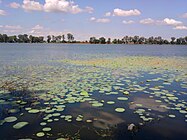Ambika (Bor Raja)
Script error: No such module "Draft topics".
Script error: No such module "AfC topic".
| Bor Raja Ambika | |
|---|---|
 Sri Sri Ambika Mahadevi | |
| Reign | 1732–1738 |
| Predecessor | Phuleshwari |
| Successor | Sarbeswari |
| Born | Ahom kingdom |
| Died | 1738 Ahom kingdom |
| Spouse | Siva Singha |
| Issue | Tipam Raja |
| Father | Chinatalia Nat |
| Religion | Hinduism |
Ambika or Bor Raja Ambika (1732–1738) was the chief consort and the Queen regent of Siva Singha (1714–1744). She was the younger sister of Bor Raja Phuleshwari[1] who also preceded her, after her death, Siva Singha married Ambika and made her the Queen regent[2] or the Bor Raja.[3] Ambika or, Draupadi was earlier married to Solal Borgohain of the Miri Sandikoi family, by whom she had two sons. Siva Singha snatched away from her husband and made her the Parvatiya Konwari.[4] Ambika was no different from her sister Phuleshwari and followed the footsteps of her sister as per Baruah (1985).[5] Her earlier name was Draupadi which was changed afterward to Ambika. Coins were minted on her name and her husband. She had famously excavated the Sivasagar Tank in the capital city of Rangpur which covers an area of 257 acres of which 127 acre is underwater, and constructed the three temples on its banks dedicated to Shiva, Devi, and Vishnu. The Siva dol with its large gold-covered dome is the biggest and tallest of the temples of Assam. Ambika was a great sponsor of learning and education[6], It was under her patronage the famous Assamese manuscript Hastividyarnava on elephantry was written by Sukumar Barkaith, the book of Dharma Puran was also translated into Assamese by Kabichandra Dvji as per the orders of Ambika and Siva Singha.[7]
Bor Raja Ambika died in 1738 of griping pain in the stomach. Her body was taken to Charaideo hill and was given a Maidam. A temple was also erected at the spot at Chinatali where the queen had breathed her last breath, and Ambika was succeeded to the position of Bor Raja by a another wife of Siva Singha, Endari who was renamed as Sarbeswari.[8] Sarbeswari was earlier married to Borpatrogohain of Kalugoan. Ambika had a son through Siva Singha, who was made the Tipam Raja or usually the heir-apparent. Of her sons from her former husband, one was made the Borgohain and the other Sadiya-Khowa-Gohain.
Photo gallery[edit]
-
Queen Ambika in the court, being glorified.
-
Sivasagar Tank/Pukhuri
-
Siva dol constructed by Bor Raja Ambika
Notes[edit]
- ↑ P. R. Gurdon (July 1927). "S.K. Bhuyan: An Assamese Nur Jahan". The Journal of the Royal Asiatic Society of Great Britain and Ireland. Cambridge University Press (3): 613. JSTOR 25221216.
- ↑ Gait, A History of Assam (PDF). p. 178. Search this book on

- ↑ Nasrin Ara Rahman, Status of Women Under The Ahoms. p. 47. Search this book on

- ↑ Bhuyan, Tungkhungia Buranji. S.K. Bhuyan, Tungkhungia Buranji. p. 41. Search this book on

- ↑ Nilam Hazarika (April 2015). "Nilam Hazarika, Women in Ahom Court Politics" (PDF). International Journal of Humanities and Social Science Invention. 4 (4): 47–50.
- ↑ Nasrin Ara Rahman, Status of Women Under The Ahoms. p. 47. Search this book on

- ↑ Raj Kumar Mazinder (April 2020). "Manuscript painting Tradition in Assam: A Concise Overview".
- ↑ S.L. Baruah, Comprehensive History of Assam. p. 295. Search this book on

References[edit]
- Baruah, Swarna Lata (1993). Baruah, Last days of Ahom Monarchy. ISBN 9788121504621. Search this book on

- Gait, A History of Assam (PDF). Search this book on

- Nasrin Ara Rahman, Status of Women Under The Ahoms. Search this book on

- Nilam Hazarika, Women in Ahom Court Politics. Search this book on

- Bhuyan, Tungkhungia Buranji. Search this book on

This article "Ambika (Bor Raja)" is from Wikipedia. The list of its authors can be seen in its historical and/or the page Edithistory:Ambika (Bor Raja). Articles copied from Draft Namespace on Wikipedia could be seen on the Draft Namespace of Wikipedia and not main one.



